30 Rare Albino Animals From Around The World
Science
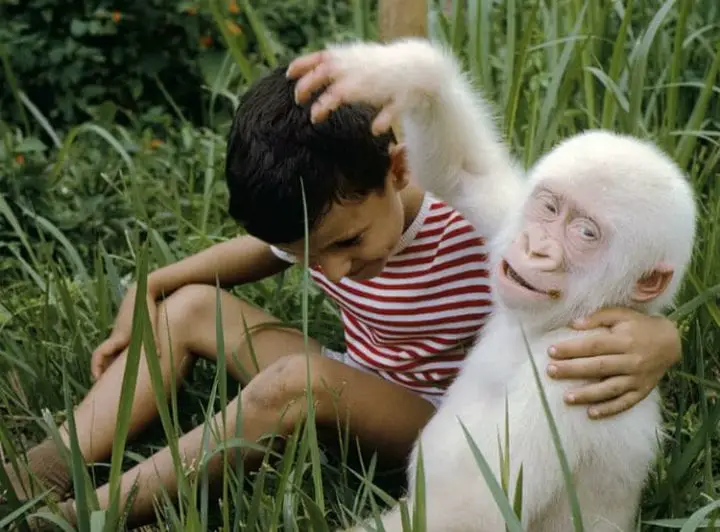
Pinterest
Abnormally white animals have mystified and charmed people for centuries with their ghostly appearances. In fact, people have loved albinos and other oddly white animals so much that they may actually be helping increase their numbers, despite all the struggles these animals face in the wild. While these unusual animals certainly did not win the genetic lottery, they’ve overcome difficult challenges regardless.
1. Onya-Birri the albino koala
Onya-Birri the albino koala was born to two perfectly normal, gray koalas at the San Diego Zoo in 1997. His name comes from an Aboriginal (indigenous Australian) phrase meaning “ghost boy” after his white fur. Since he is a marsupial, Onya-Birri spent his first six months in his mother’s pouch.
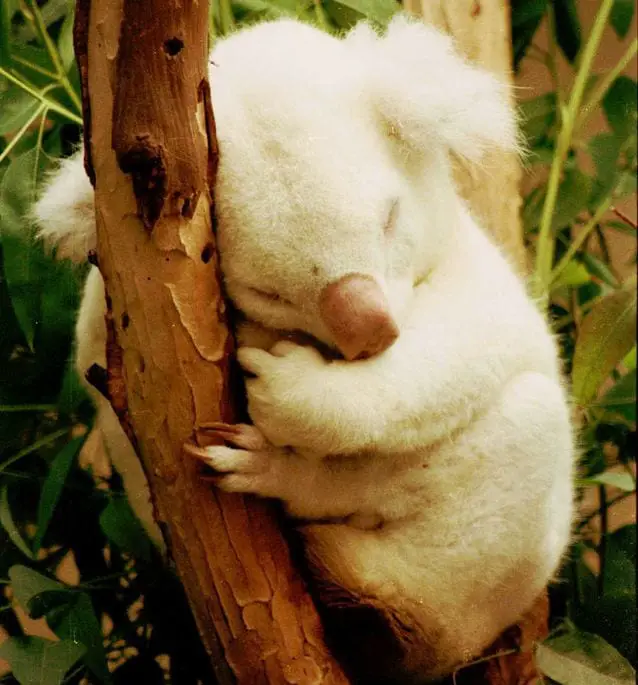
Mother Nature Network
When Onya-Birri popped his face out of mom’s pouch, the zoo staff were surprised by his white fur and pink nose. Albino koalas, like most albinos, are very rare, but they have been found in the wild before. Once out of the pouch, this little ghost boy had to learn how to live life as both a koala and an albino.
2. The Seneca White Deer
A whole herd of white deer lives at the Seneca Army Depot in New York. These white-tailed deer were trapped within the fence of the depot when it was built and as the years went on, they bred and their population grew. However, these deer aren’t true albinos, because they still have pigment in their eyes.
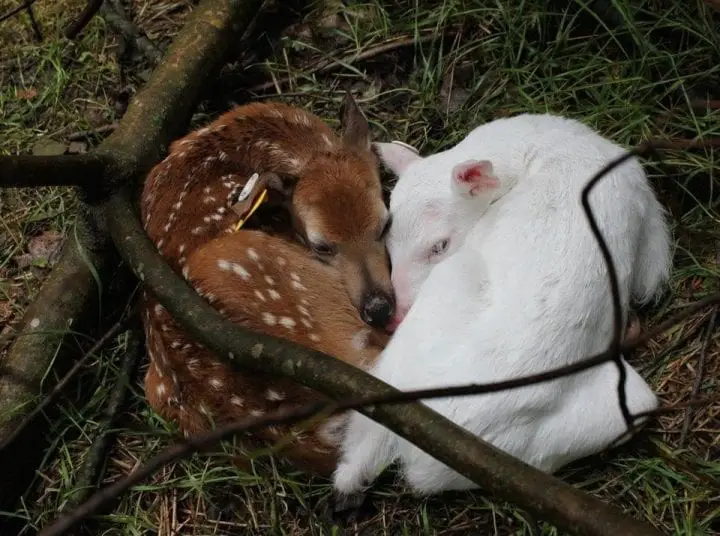
Reddit
Albinos don’t produce melanin at all, which is the pigment that gives color to skin, eyes, hair, scales, and feathers. Albino eyes are either pink, light blue, or green because the red blood vessels are showing through or because of how light passes into the iris.
3. Snowflake the albino gorilla
Snowflake the albino Western lowland gorilla was only a youngster when he was found in the wild. He was given a home at the Barcelona Zoo, where he lived a full life of 40 years (normally gorillas live 30 to 40 years). But while he was a rare beauty to zoo visitors, his albinism was no happy accident.

Pinterest
Snowflake developed skin cancer, which albinos are particularly susceptible to because they don’t have melanoma protecting them from the sun’s UV radiation. Later, researchers analyzed Snowflake’s DNA and found that he was actually inbred, which is how he got two pairs of a rare and recessive albinism gene.
4. The leucistic peacock
Like the Seneca White Deer, this peacock is not albino, but does have a partial loss of pigment. This genetic condition makes it leucistic, which is more common than albinism but still pretty rare. Animals with leucism can be all white, or partially white, but they all have pigment in their eyes. This sets them apart from true albinos.
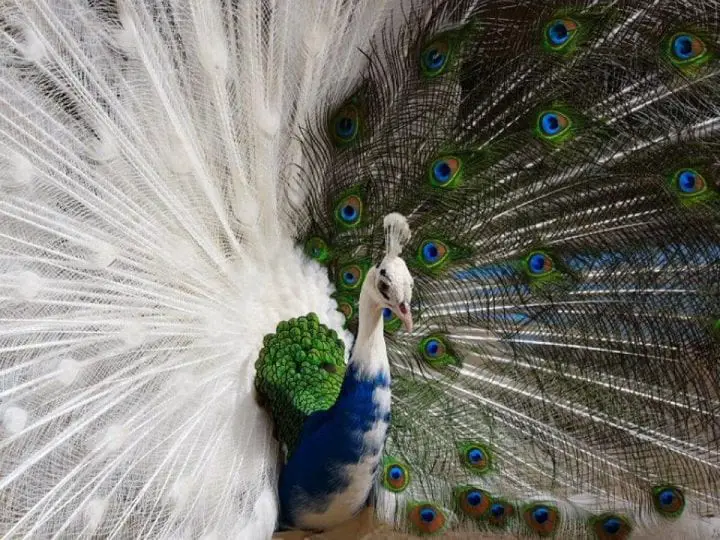
Reddit
Peacocks use their elaborate and colorful feather train to attract mates, aka the surprisingly brown peahens. The females pick their suitors based on the length of the train, how many blue feather “eyes” it has, and the pattern’s symmetry. This peacock probably couldn’t get a mate due to his half-white feathers.
5. The white reindeer
Albino and leucistic animals often have a hard time surviving in the wild. They can have health conditions, like skin cancer, but they also lack their species’ usual camouflage. For example, you probably didn’t even notice the brown reindeer in the picture below. The white one stands out so much that predators can easily see it.
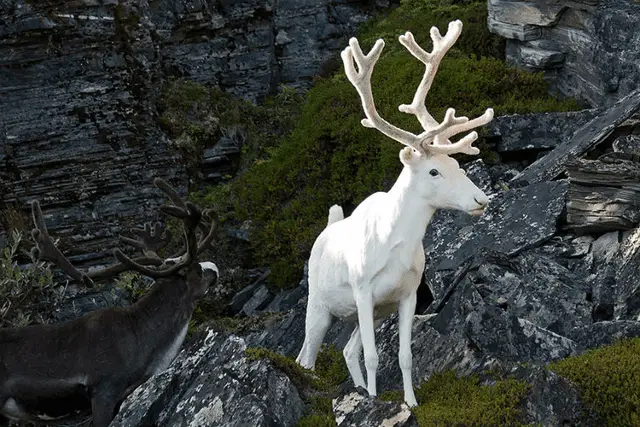
Bored Panda
Perhaps once winter hits and snow blankets the environment, this leucistic reindeer will have the advantage. But among its brownish-gray peers in Norway, Sweden, and Finland, this reindeer is as rare as a reindeer can get, second only to red-nosed Rudolph. Some people believe seeing one is good luck.
6. The albino hummingbird
This snow-white beauty was caught on film by fifteen-year-old photographer Marlin Shank in Virginia. The bird is an albino ruby-throated hummingbird feeding on the nectar of a butterfly bush. Normally, these hummingbirds have green backs and heads, with gray-white stomachs. The males sport bright red feathers on their throat.
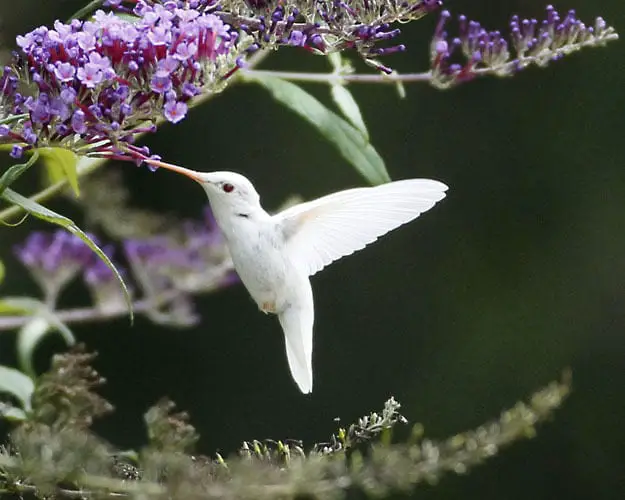
Marlin Shank
Hummingbirds are excellent fliers, darting around the air with ease. They can stop in an instant and hover in midair, then move up, down, sideways, or backward. While they’re known for their appetite for nectar, they also eat insects and spiders. Males will fight over flowers, aggressively defending their food from other hummingbirds.
7. The white lioness of South Africa
Elusive and leucistic white lions have been spotted in South Africa occasionally for decades. Myth surrounded these animals, with legends saying a meteor strike gave them their white fur. However, despite the mysticism, they are very much real. A pair of white lion sisters were born in 2009 in South Africa’s Kruger Park.
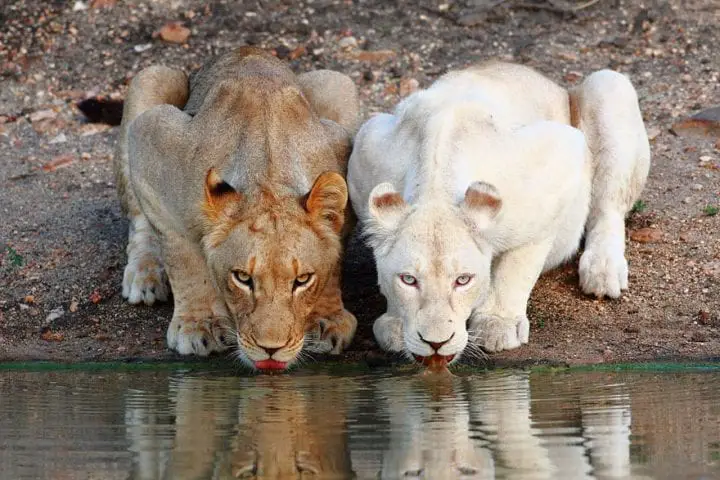
Chad Cocking
Since the lions still have dark noses, they aren’t albino, but leucistic. Their coloring is not exactly helpful since lions use their coloration as camouflage while hunting. Fortunately, lions live in prides and hunt together. The sisters in Kruger Park grew up under the protection of their mother and aunt, but it wasn’t easy.
8. Lucky the albino lobster
Lucky the lobster certainly looks like he’s jumped on the pastel unicorn trend, but his beautiful carapace is most likely due to albinism or leucism. While albinism is often a handicap, it actually saved Lucky’s life. A fisherman caught him in a net but spared him from the restaurant biz. Now, this unicorn of a lobster lives at a Canadian aquarium.
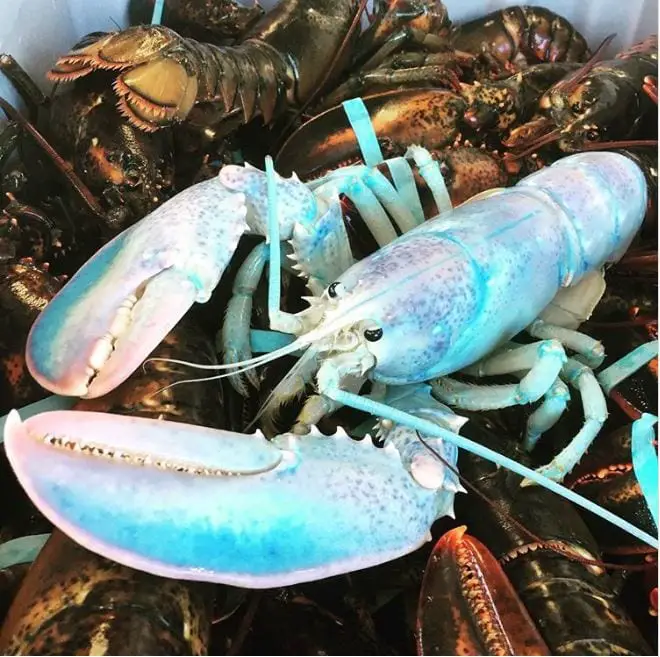
Robinson Russell
Lobsters are normally greenish-brown and only turn red once cooked because the heat breaks down certain proteins the red pigment is attached to. However, there are other colorful lobster variants: blue, orange, yellow, calico, and split-toned. Albinos are the rarest, with the odds of catching one at one in 100 million.
9. The wise white moose
White moose have been spotted across the world, in both North America and Europe. They appear to be wise old forest spirits moseying their way through grass, rivers, and trees. And as with any leucistic or albino animal, white moose are rare, but their population may be growing.
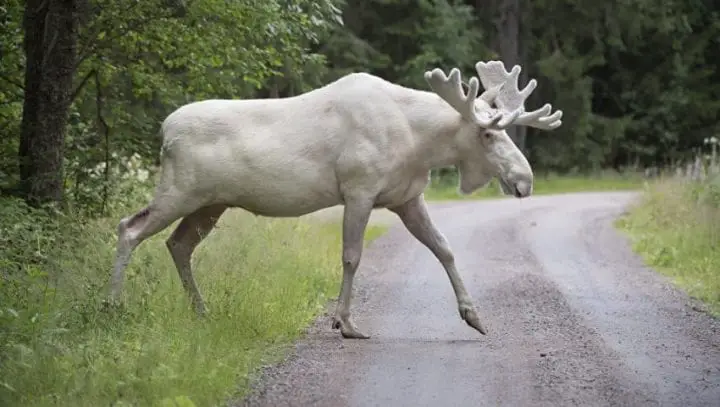
sputniknews.com
Where there are few natural predators, humans could be influencing the amount of white moose in the area. For instance, in Scandinavia, hunters spare the white moose and take the normal colored ones instead. Perhaps this will lead to white moose mating with each other more, spreading their recessive genes through the population.
10. The ghostly white giraffe
Giraffes live in scattered populations across Southern and Eastern Africa, but only a few white ones have ever been seen. Unfortunately, giraffe numbers are decreasing, because they face threats from habitat loss, illegal hunting, civil unrest, and climate change. Currently, giraffes are listed as vulnerable to extinction.
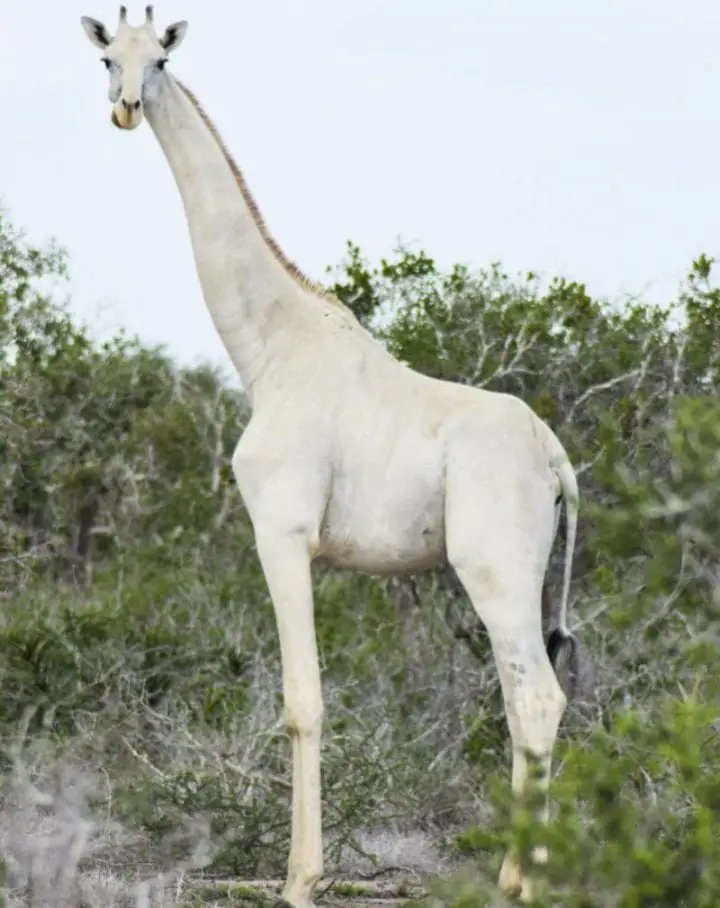
TwistedSifter
The human population in Africa is growing rapidly, putting immense pressure on the animals living there. Some of their habitats are turned into agricultural land, but some are simply degraded from mining and climate change. In areas where hunting giraffes is illegal, they’re doing better, but poaching is still a huge threat in some countries.
11. Alby the albino sea turtle
A couple of years ago, a tiny albino green sea turtle struggled to emerge from the sand on Australia’s Castaways Beach. From there, he awkwardly shuffled across the beach with one mission: get to the water. Alby the turtle had no idea he was special, he was just dealing with the normal struggles of a newly hatched sea turtle.
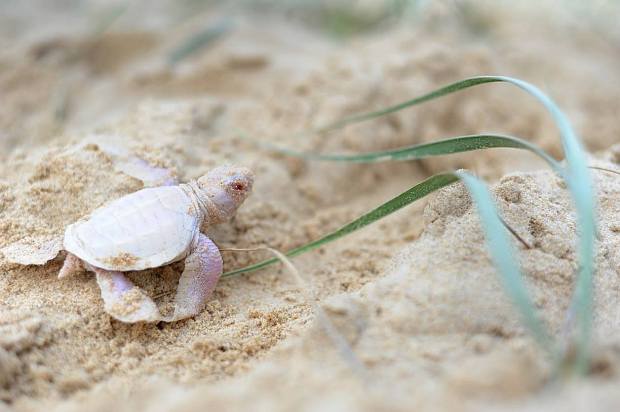
Adrienne savage/Facebook
However, Alby was a little behind. His 121 siblings had hatched the day before, making their own perilous journey to the ocean. Hopefully, this little one will survive and grow up happily in the ocean. He could potentially grow to be 700 pounds!
12. The giant, carnivorous albino snail
In the bushland of New Zealand, a group of hikers stumbled across a rare white snail. The morning’s rain had brought it out of hiding, possibly to hunt earthworms and slugs. But upon emerging, the snail also subjected itself to the threat of predators.
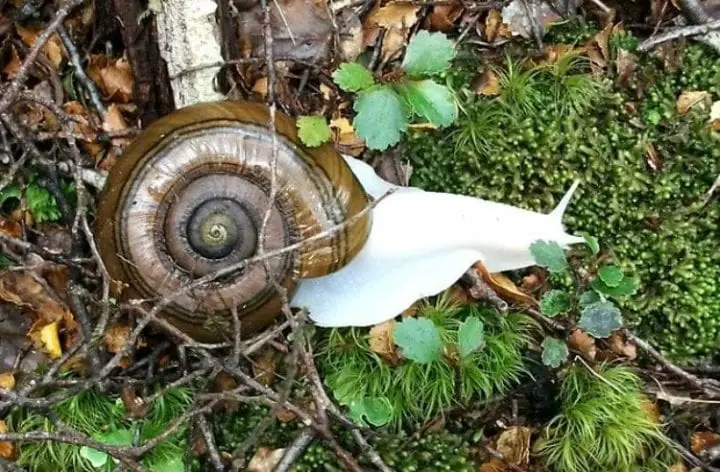
New Zealand Department of Conservation
This species of snail, Powelliphanta hochstetteri hochstetteri, is endangered because opossums, rats, and pigs were introduced to New Zealand. They eat the large snail, and the white skin probably only raises this risk. Normally, this snail species is deep black against its brownish-yellow spiraled shell. This particular snail, though, appears to be 10 years old so it’s doing pretty good.
13. Zoe the golden-white zebra
Zoe the zebra is like a blondie to a normal zebra’s brownie — different, but still just as good. She was born in captivity on the Hawaiian Island of Molokai, but what is she losing by not having the iconic black stripes? Well, contrary to what you probably learned in school, scientists aren’t sure why zebras have stripes.
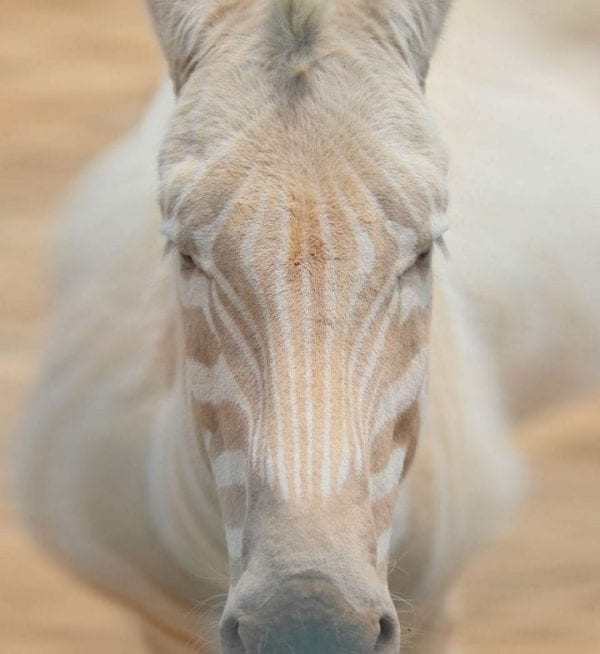
Bill Adams
There are several plausible explanations for the stripes’ function, including protection against insects, confusion for predators, and some sort of social interaction. However, researchers are pretty sure the stripes don’t help cool the zebras down, as some have hypothesized in the past.
14. The white Gentoo Penguin
Ornithologist Noah Strycker traveled to South Georgia Island, an island off the continent of Antarctica that’s home to many thousands of penguins. This little white penguin stood out starkly among its tuxedo-d peers. While the white feathers may be camouflage in the snow, they aren’t camo where it counts.
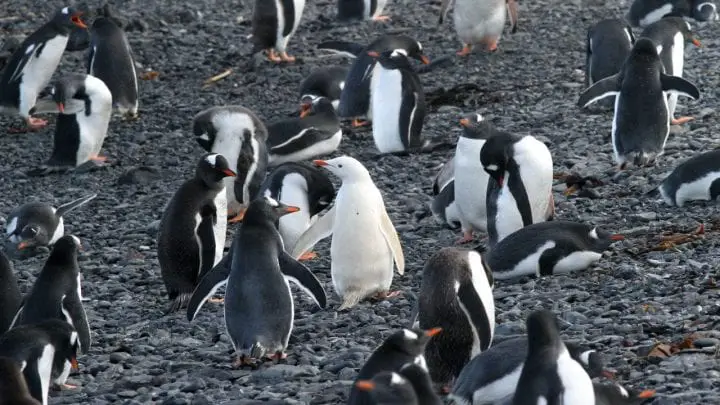
Noah Strycker
Penguins are black and white because the “countershading” is effective for blending in when underwater. This coloration is common in sharks, tuna, and other marine predators. The dark top is hard to see when someone looks down at them, while the lighter underside blends in with the light when looked at from above.
15. The white kangaroos
While it’s tough to say if this white kangaroo is albino or not, it does seem that white kangaroos are popping up more and more in Australia. It’s possible that the 3,488-mile long dingo fence they installed is keeping white kangaroos safe from predators when normally their fur color would make them especially vulnerable.
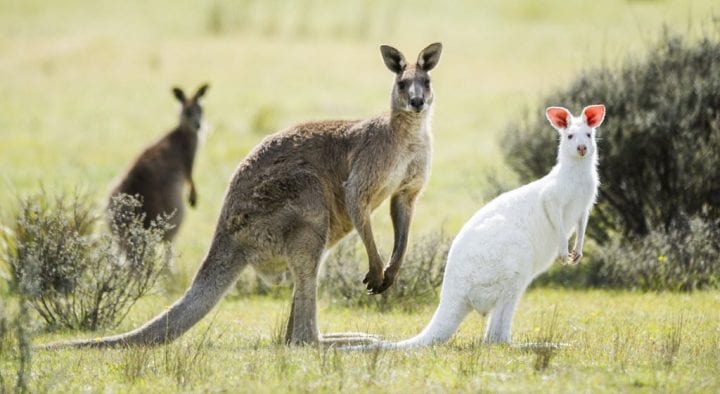
National Geographic
Alternatively, the drought could be bringing kangaroos closer to human settlements, generally increasing the number of kangaroos people are seeing. The large marsupials live in social groups called mobs and one wildlife magazine editor saw a mob apparently protecting a white kangaroo in the group from danger.
16. The kooky kookaburra
The laughing kookaburra is normally brownish, with a light stomach and dark back, but this albino is simply a little puffball. These birds are well known for their call, which is a mix of chortles and chuckles and a shrieking laugh. They do it at dawn and dusk to tell everyone that this is their territory.
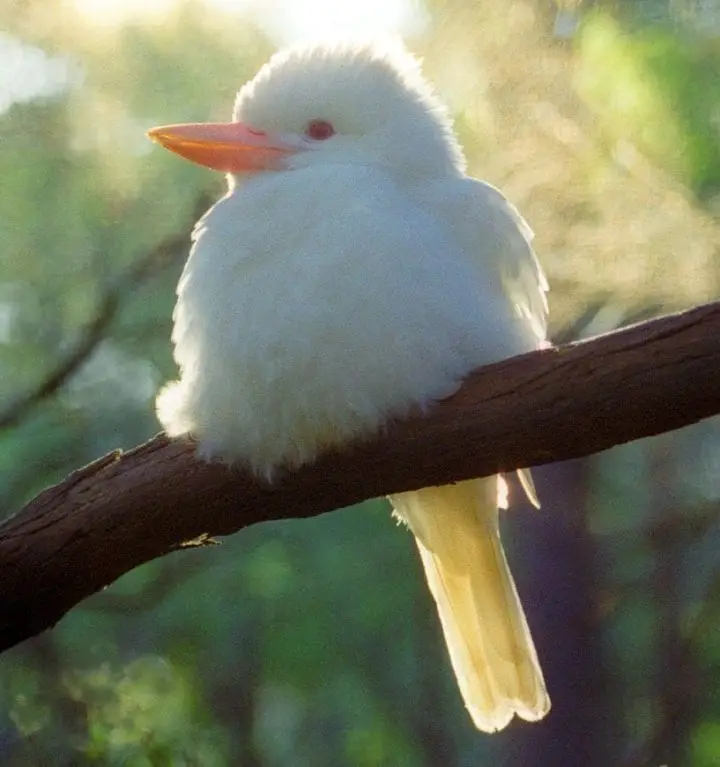
Buzzfeed
Kookaburras live in Australia, where they brave the dangerous insects, spiders, and snakes. In fact, they actually eat snakes that are up to three feet long. But when they’re not viciously banging a snake into the ground, kookaburras are snuggling up to their life-long mate.
17. Manukura the snow-white kiwi
Manukura looks like a little snowball that grew legs and a beak, but she is actually a kiwi, a bird native to New Zealand. She’s a resident at Pukaha Mount Bruce National Wildlife Centre, where she lives among other kiwis in their Kiwi House. She was one of three white chicks, but the other two were released into a reserve.
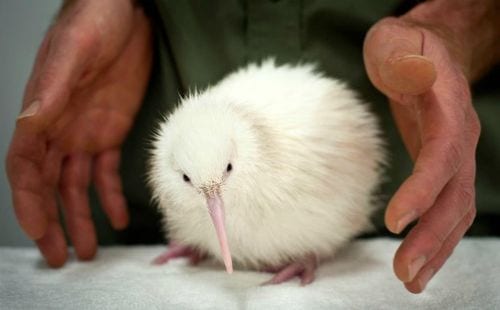
ZooBorns
She had a little trouble at six months old when two stones got stuck in her gizzard. But vets were able to use lasers to break the rocks and Manukura recovered successfully. Birds eat stones to aid their digestion, but Manukura must have had eyes bigger than her stomach.
18. Claude the albino alligator
Claude the albino alligator warms himself on a heated rock at the California Academy of Sciences, where he’s lived for the last 10 years. On his fifteenth birthday, they threw him a party with cake, hats, and singing. But the now 23-year-old still has a lot of life left — he could live to be 80.
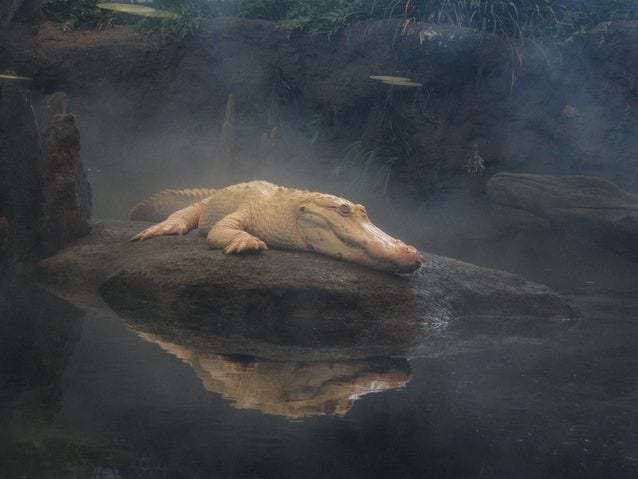
Mother Nature Network
Unfortunately, besides the alligator snapping turtles and freshwater fish that live in the swamp exhibit with him, he may have to go without other alligators. For about a year, he lived with another gator named Bonnie, but she became impatient with Claude. His albinism gives him poor eyesight, so he kept bumping into things and she bit him on the leg.
19. The mythical white ravens of Vancouver Island
Several white ravens have hatched on Vancouver Island, Canada, where genetics are lining up just right to make these mystical birds. However, this isn’t the only place to have seen white ravens. There are many different tales and legends about them, from Greek mythology to Native American stories.
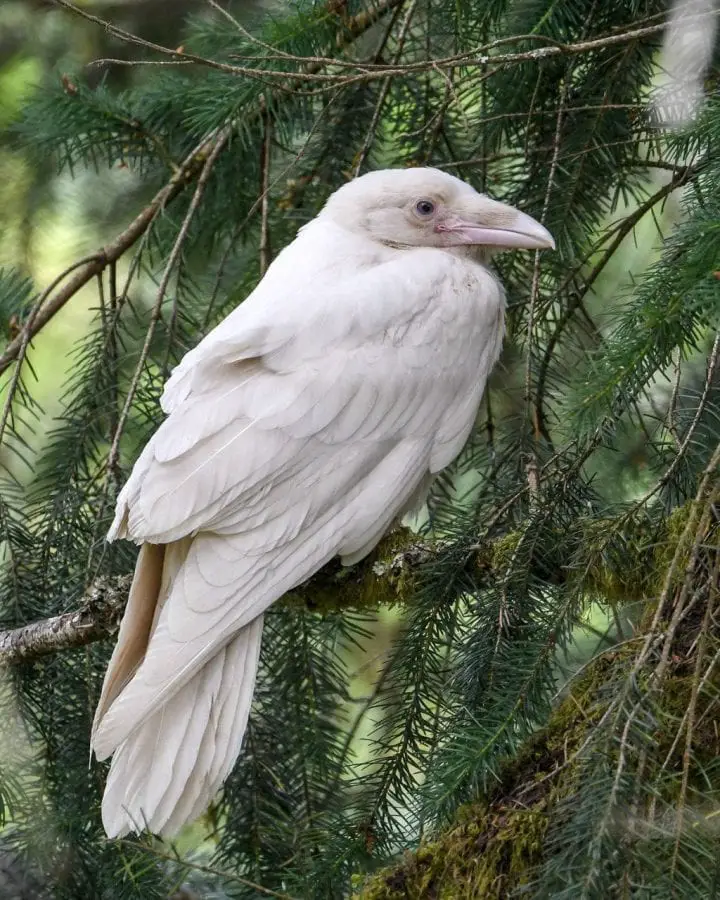
Mike Yip
A common theme is that ravens were originally white, but then shenanigans ensue that turn ravens black forever. Of course, as we can see, ravens are not all black. The rare few ravens (and crows) are leucistic or albino. Some have white feathers mixed in with black while others are all white.
20. The spirit bears of the Great Bear Rainforest
Deep in the Great Bear Rainforest of British Columbia live a group of walking oxymorons: the white black bears. Also known as Kermode bears or spirit bears, they aren’t polar or albino, but have a recessive mutation in the same gene that’s associated with redheaded humans. They’re surprisingly common in this area, with one white bear in every 40 to 100 black bears.
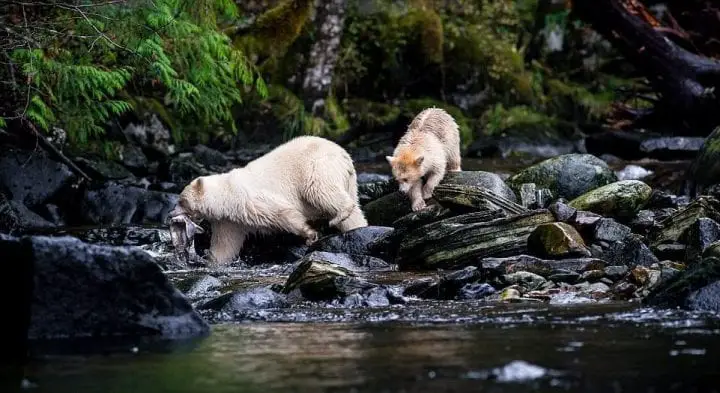
Kyle Breckenridge/Solent News
The indigenous people around the forest never hunted the white bears or talked about them to trappers, so now there are between 400 and 1,000 living in the cool rainforest. Plus, if you kill one, you could be fined up to $104,000.
21. Pinky the albino dolphin of Lake Calcasieu
Swimming in the brackish Lake Calcasieu of Louisiana, Pinky the albino dolphin surprised onlookers with its abnormally pink skin. Pinky looks like just another fake internet animal or perhaps a tall tale from summer camp, but the dolphin has been living in the area for at least eight years.
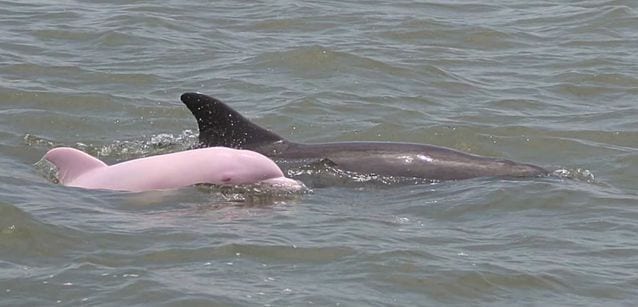
Mother Nature Network
Pinky gets its surprising pink skin from its albinism. Its cells don’t make the melanin pigment that would give it a normal gray color, so just the color of the dolphin’s blood vessels show through. Since albinism is genetic, Pinky’s parents both had the recessive gene for it and passed them on to Pinky.
22. The albino tawny frogmouth
This tawny frogmouth must have seen something truly surprising — like an albino animal. That would be a real shocker. This special bird was found on the ground and rehabilitated, where it met this friend. The two were released once they were healthy enough. Tawny frogmouths normally live in pairs, committing to their mate for life.
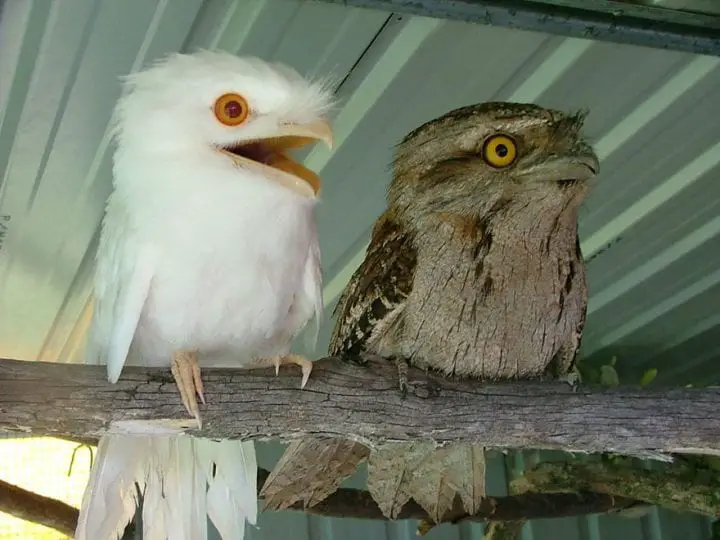
Bored Panda
Together, the pair controls a small amount of territory for hunting, sleeping, and breeding. They raise chicks each year, defending their nest from predators. Instead of using their feet to grab prey, tawny frogmouths use their enormous mouths and hooked beaks to get insects and other small animals.
23. The albino mother raccoon
This albino mother raccoon may be wondering why her babies look nothing like her. But even so, she’s happy for the free meal of dog food that the photographer’s friend had been hiding in the stump. Raccoons actually wash their food before eating it, using their highly dexterous hands.
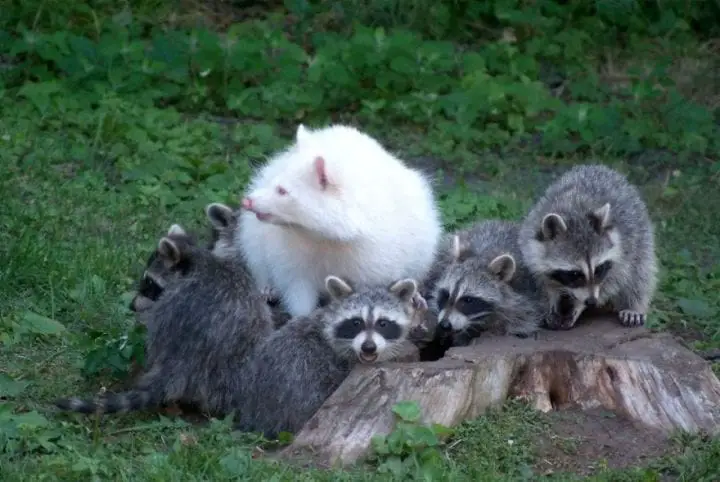
Rick Stockwell
This bright white raccoon probably can’t be a bandit anywhere but the North and South Poles, where she’d blend right in with the snow. Perhaps Santa Claus will find this raccoon rummaging through his trash. But she may not like the Arctic, because she’d have to wash her food in the freezing ocean.
24. Migaloo Jr. the white humpback whale
Migaloo Jr. the white humpback whale is believed to be the offspring of Migaloo, the first white humpback whale ever recorded. The two live off the east coast of Australia, but it’s unclear if they are albino or not. “Migaloo” is an Aboriginal word meaning “white man,” so it’s a pretty fitting moniker.
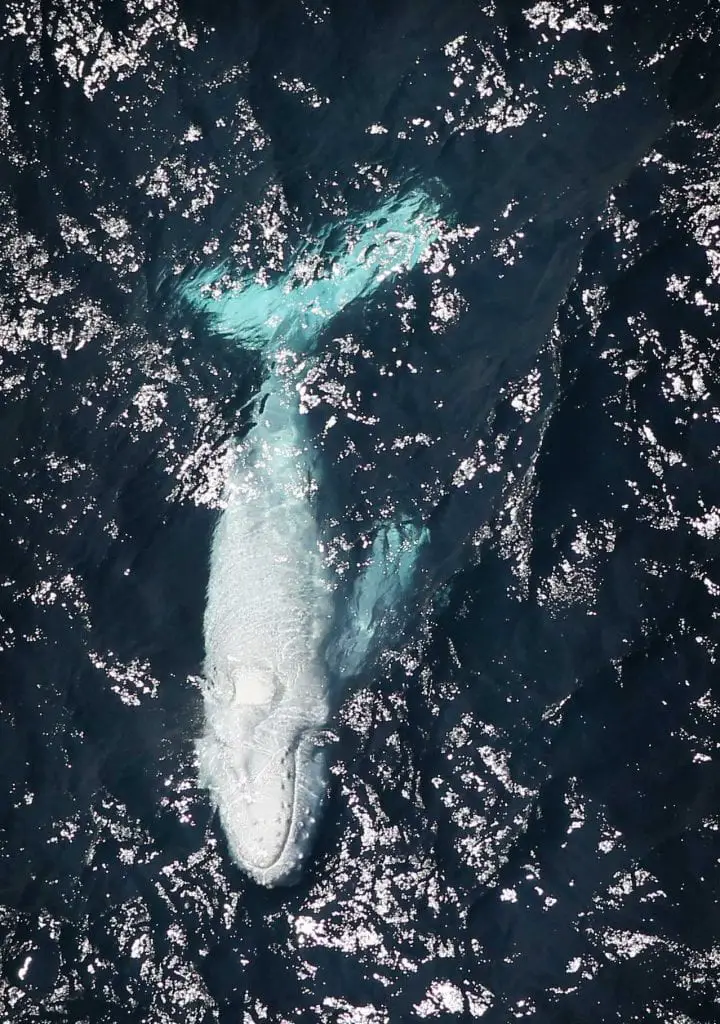
The White Whale Research Centre
No one knows if Migaloo Jr. is actually related to Migaloo. He would have had to mate with either another white whale or a normal colored one carrying the same recessive gene. Even then, the offspring are not guaranteed to be white. Migaloo is distinctive from Migaloo Jr. because he has back scars from an old boat collision.
25. The albino ball pythons
Pythons are constrictor snakes, so they squeeze their prey to death by suffocating it, but that hasn’t stopped people from keeping them as pets. Normally dark brown with lighter brown splotches, ball pythons are often bred for abnormal coloration. When albino, their scales are white with yellow patterning.
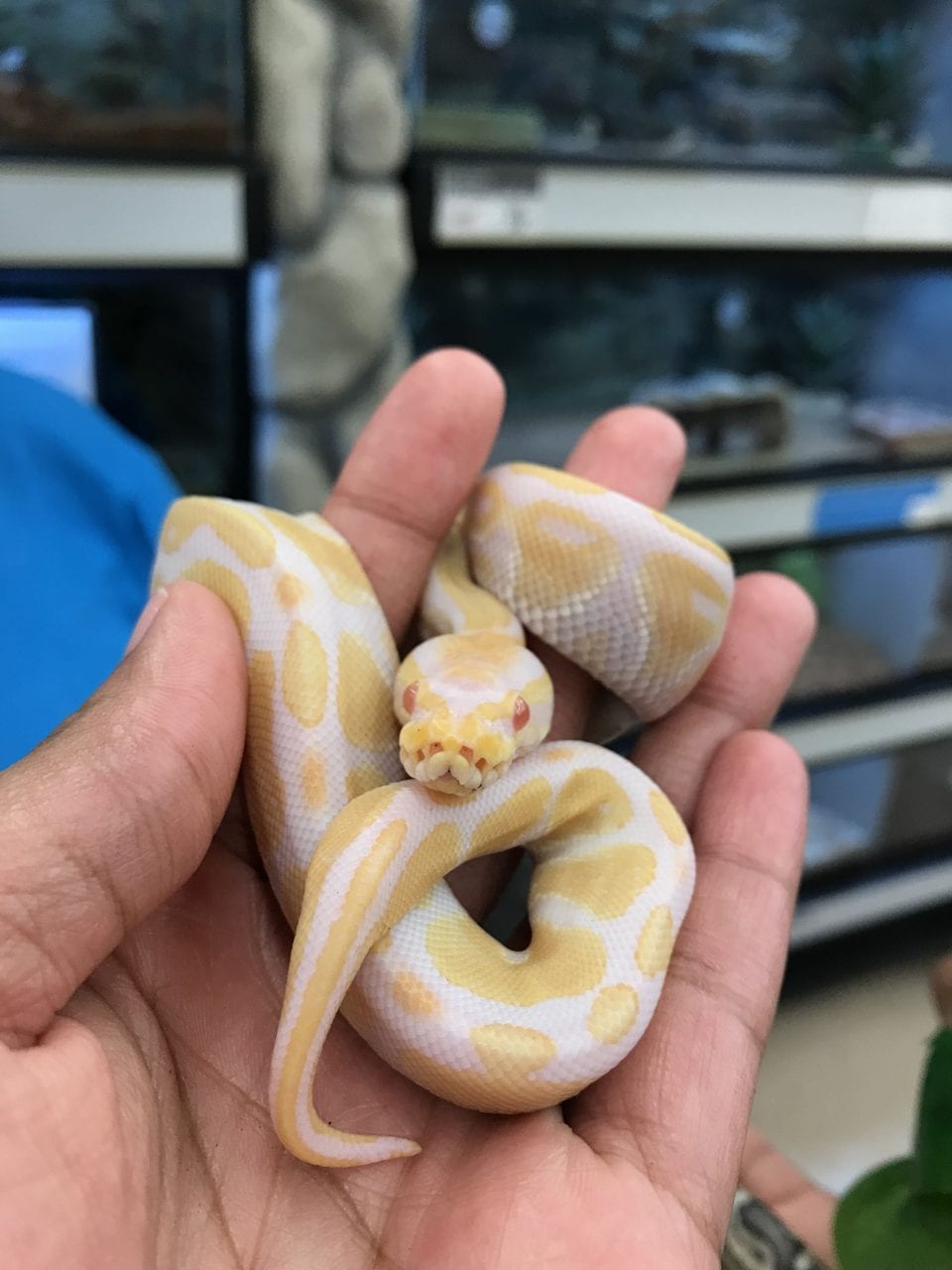
Pinterest
Albino ball pythons are a popular pet, so breeders carefully select snakes for mating to keep the albinism visible. However, some albino ball pythons will lose their white coloring and become almost completely yellow. Since breeders discovered the albino ball python, they’ve made a variety of other color variations to sell as pets.
26. Luna the albino screech owl
Luna the albino eastern screech owl fell out of his nest as a youngster, but someone found him and brought him to Peace River Wildlife Center in Florida. It might have been lucky for him to fall out of the nest, though, because albinos often struggle in the wild. He had no camouflage to protect against predators.
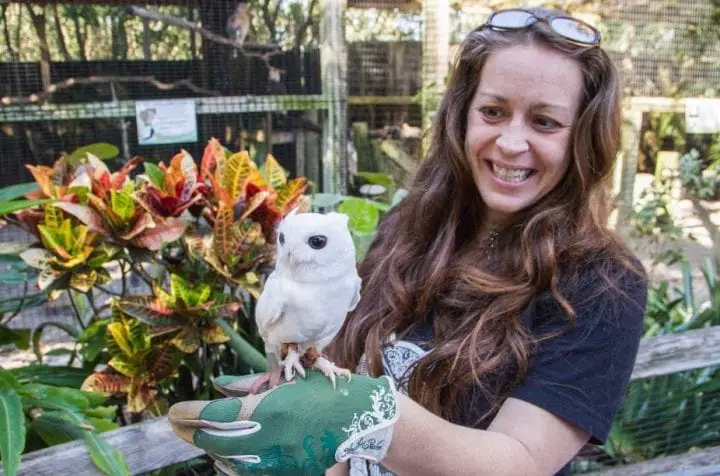
Barcroft Animals
While the center’s staff probably could have rehabilitated and released the little owl, they doubted he’d be able to survive. Raccoons, hawks, and larger owls are all predators of eastern screech owls. Now, Luna does educational shows for visitors and loves being handled.
27. The albino crested porcupine
The largest porcupine in the world, the African crested porcupine lives in grassy and rocky areas in North and sub-Saharan Africa and Italy. When threatened, they raise their quills into a crest, stamp their feet, click their teeth, and rattle their quills. If that doesn’t drive off the predator, the porcupine runs backward to ram the potential attacker with sharp quills.
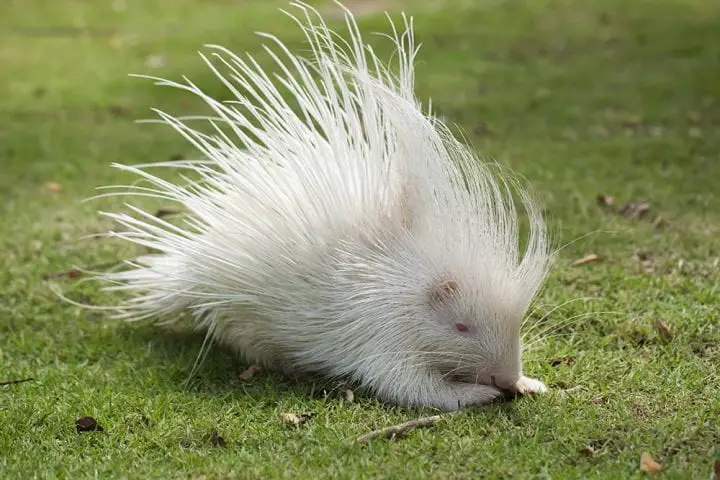
Chiang Mai Night Safari
Porcupines live underground in burrows in monogamous pairs. Their babies are called porcupettes and are born in a specific birthing chamber in the burrow. At first, their quills are soft, but at a week old they begin to harden and the porcupettes venture out of the den.
28. The albino squirrels of Olney, Illinois
A small town in Illinois has somehow found itself overrun with albino gray squirrels. They have a couple of legends about how it came about, but it seems that in 1902 someone brought a few albino squirrels to a saloon, where they were put on display. After a while, the squirrels were released and evidently, they reproduced.
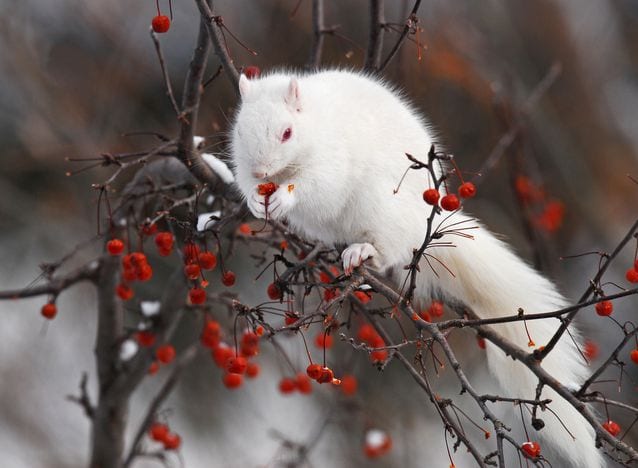
Mother Nature Network
The town has since embraced their squirrels, making it their trademark gimmick. They even have a law that squirrels have the right of way on streets. Plus, it’s illegal to harass the squirrels and you’d face a fine up to $750. Every year, the town counts their albino squirrels to see how the population is doing, but it’s likely the albino squirrels will eventually disappear.
29. The leucistic cardinal
Normally, male cardinals are red with a black face and females are brown with red-tinged feathers. However, there is a range of color variations depending on how much pigment the bird’s cells produce. No matter what their coloration, pretty cardinals are songbirds and often travel in pairs.
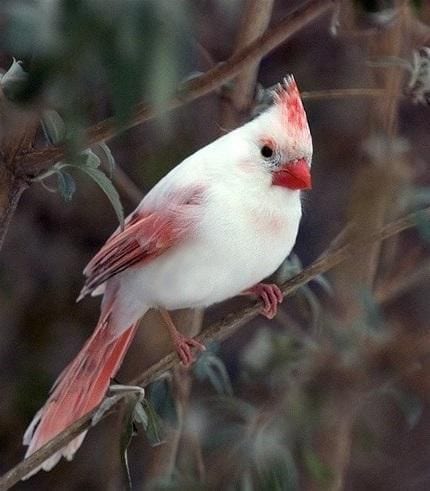
Pinterest
A cardinal can raise and lower the crest on its head, depending on if it’s agitated or resting. Before making a nest, cardinal pairs travel around looking for the perfect spot, like a couple on House Hunters. She remarks about how the spot doesn’t have something or other, and he remarks about how it’s out of their price range.
30. The leucistic nurse shark
As you must have learned by now, all kinds of different animals can have mutations that change their color. For example, this spotted, leucistic nurse shark smoothly glides around the seafloor. However, contrary to what some people think, it does not need to keep swimming just to breathe.
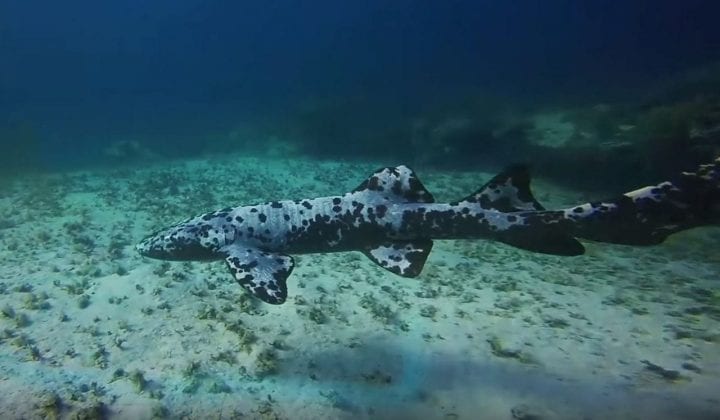
JFC Studios
Some shark species have to continuously swim, to force oxygen-filled water over their gills, but not nurse sharks. Nurse sharks use a method called “buccal pumping” to get water flowing through their gills. To do this, their mouth actively brings in water. As a result, nurse sharks can lounge on the seafloor as often as they please.